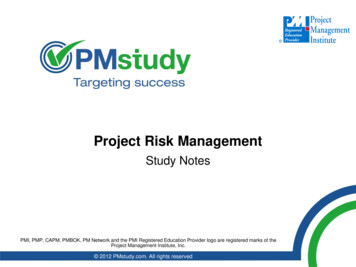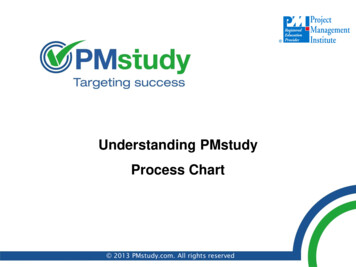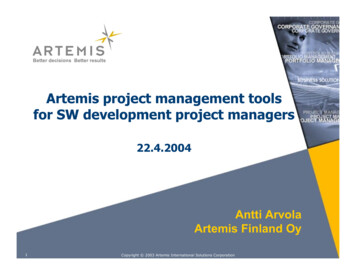
Transcription
Project Risk ManagementStudy NotesPMI, PMP, CAPM, PMBOK, PM Network and the PMI Registered Education Provider logo are registered marks of theProject Management Institute, Inc. 2012 PMstudy.com. All rights reserved
Points to Note Please read chapter 11 from Project Management Institute, A Guide to the ProjectManagement Body of Knowledge, (PMBOK Guide) – Fourth Edition, Project ManagementInstitute, Inc., 2008 (pages 273 to 312). The study notes explain topics that are important for PMP exam preparation and you canexpect several questions from these topics. Pay close attention to all the terms used. It is very important to understand all the conceptsdiscussed in this chapter. Try to relate the concepts to real life examples. After reading the study notes, please answer the chapter test questions in this KnowledgeArea. The chapter questions improve your understanding of the concepts discussed in thisstudy notes. 2012 PMstudy.com. All rights reserved2
What is Project Risk Management? Systematic process to identify, analyze, and respond to project risks Major risk management processes are: Plan Risk ManagementIdentify RisksPerform Qualitative Risk AnalysisPerform Quantitative Risk AnalysisPlan Risk ResponsesMonitor and Control RisksPlease refer to figure 11-1, PMBOK Guide Fourth Edition, page 274. This provides anoverview of Project Risk Management. 2012 PMstudy.com. All rights reserved3
Understanding Terms and Concepts Risk Management is not only one of the most extensive process areas in project managementcontaining several terms and concepts which need to be understood but also the most vital forproject success. Please study the terms and concepts in this Knowledge Area very carefully as explained inPMBOK Guide Fourth Edition. 2012 PMstudy.com. All rights reserved4
Plan Risk Management Process to define how to conduct the risk management activities for a project Uses planning meetings and analysis as a technique Output is: Risk management plan, which includes: Methodology Roles and responsibilities Budgeting Timing Risk categories Definitions of risk probability and impact Probability and impact matrix Revised stakeholders’ tolerances Reporting formats Tracking 2012 PMstudy.com. All rights reserved5
Identify Risks Process that determines which risks may affect the project and documents their characteristics Tools and techniques used are: Documentation reviews Information gathering techniques Brainstorming Delphi technique Interviewing Root cause analysis Checklist analysis Assumptions analysis Diagramming techniques Cause and effect diagrams System or process flow charts Influence diagrams SWOT analysis Expert judgment Output is: Risk register 2012 PMstudy.com. All rights reserved6
Perform Qualitative Risk Analysis Process to prioritize the identified risks for further action or analysis Rapid and cost-effective means to prioritize risks for Plan Risk Responses process Lays foundation for Perform Quantitative Risk Analysis process, if required Has to be re-visited throughout the project life cycle to stay current with changes in the projectrisk Leads into Perform Quantitative Risk Analysis process or directly into Plan Risk Responseprocess Tools and techniques used are: Risk probability and impact assessmentProbability and impact matrixRisk data quality assessmentRisk categorizationRisk urgency assessmentExpert judgment 2012 PMstudy.com. All rights reserved7
Perform Qualitative Risk Analysis(continued) Output is: Risk register updates:The main components that are updated include: Ranking or priority of project risks Risks grouped by categories Causes of risk or project areas requiring particular attention List of risks requiring responses in the near-term List of risks for additional analysis and response Watchlists of low priority risks Trends in qualitative risk analysis response 2012 PMstudy.com. All rights reserved8
Perform Quantitative Risk Analysis Process that analyzes numerically the probability of occurrence of each risk and its consequence onproject objectives, as well as the extent of overall project risk Follows Perform Qualitative Risk Analysis process Tools and techniques used are: Data gathering and representation techniques: Interviewing Probability distributions Quantitative risk analysis and modelling techniques: Sensitivity analysis Expected monetary value analysis Modelling and simulation Expert judgment Outputs are: Risk register updates:The main components that are updated include: Probabilistic analysis of the project Probability of achieving cost and time objectives Prioritized list of quantified risks Trends in quantitative risk analysis results 2012 PMstudy.com. All rights reserved9
Plan Risk Responses Process that develop options and actions to enhance opportunities and to reduce threats to projectobjectives Tools and techniques used are: Strategies for negative risks or threats: Avoid Transfer Mitigate Accept Strategies for positive risks or opportunities: Exploit Share Enhance Accept Contingent response strategies Expert judgment Outputs are: Risk register updates Risk-related contract decisions Project management plan updates Project document updates 2012 PMstudy.com. All rights reserved10
Monitor and Control Risks Process that implements risk response plans, tracks identified risks, monitors residual risks, identifiesnew risks, and evaluates risk process effectiveness throughout the project Also involves: Opting for alternative strategies Implementing contingency plan Taking corrective actions Updating the project management plan Tools and techniques used are: Risk reassessment Risk audits Variance and trend analysis Technical performance measurement Reserve analysis Status meetings Outputs are: Risk register updates Organizational process assets updates Change requests Project management plan updates Project document updates 2012 PMstudy.com. All rights reserved11
Utility Function Ultimate decision on how to deal with risk is based in part on Project Manager’s tolerance forrisk – this is measured by Utility function. Y axis refers to Utility, i.e. satisfaction that the project manager gets from a payoff. X axisrefers to the amount of money at stake.UU Risk NeutralU Risk Averter Risk SeekerReference: A System’s Approach to Planning, Scheduling and Controlling, page 906 2012 PMstudy.com. All rights reserved12
Please read chapter 11 from Project Management Institute, A Guide to the Project Management Body of Knowledge, (PMBOK Guide) – Fourth Edition, Project Management Institute, Inc., 2008 (pages 273 to 312). The study notes explain topics that are important for PMP exam preparation and you can expect several questions from these topics.











